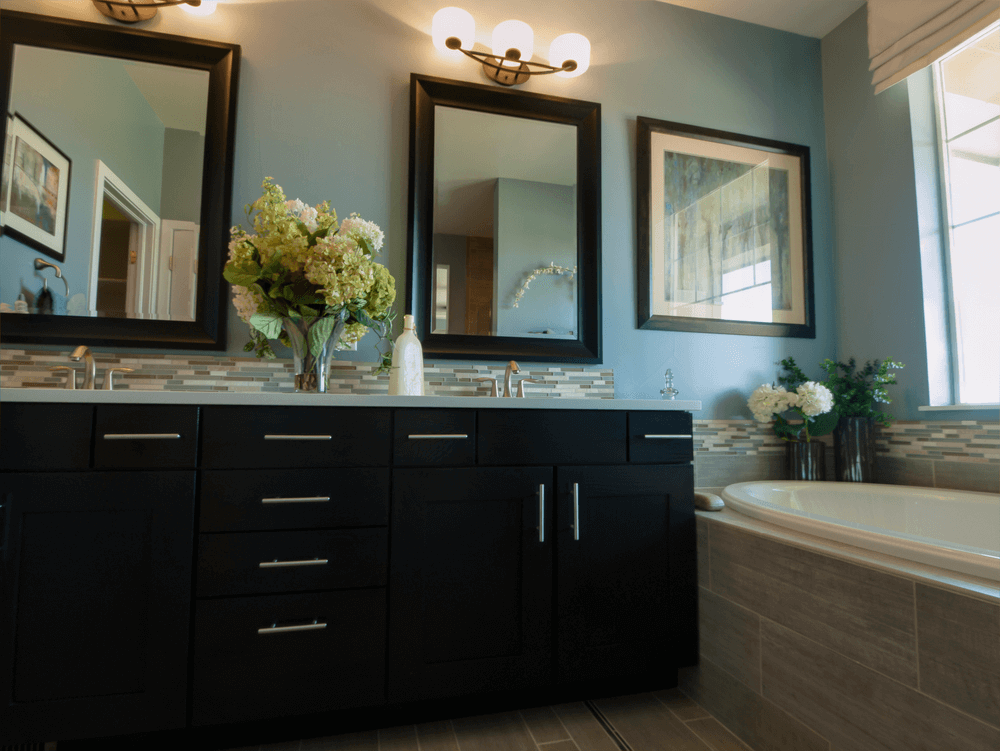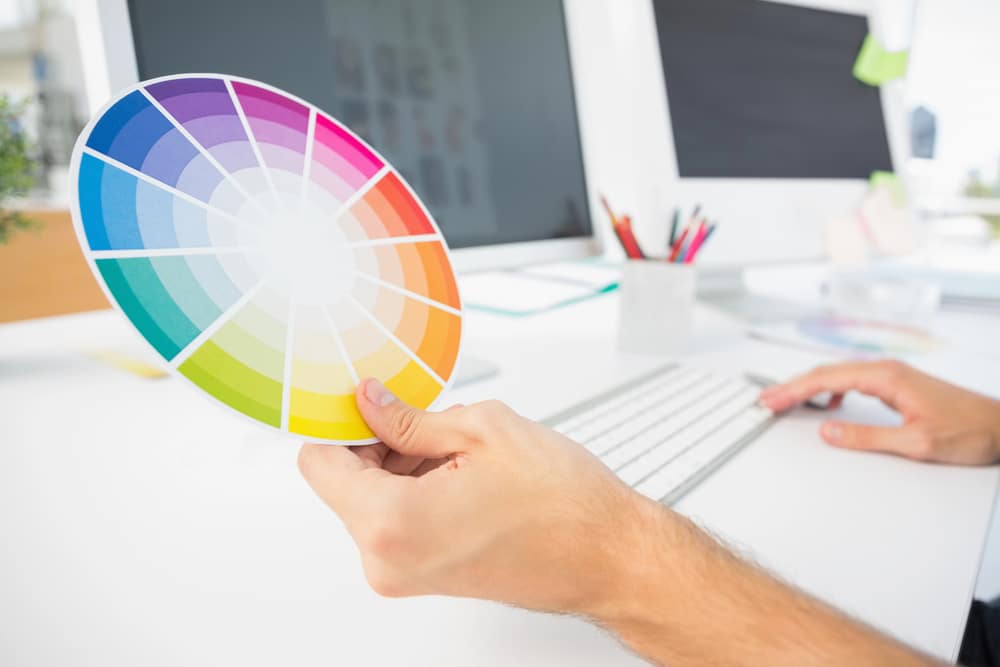
Call Us Today!

Call Us Today!

Deciding on the perfect color scheme for your bathroom involves more than just selecting shades that appeal to you. It requires understanding the balance between colors that soothe and those that energize, and making sure they match your personal style.
This guide from Kind Home Solutions aims to help you with practical tips and insights into creating a harmonious color palette that reflects both your bathroom’s space.
Get help with interior painting at Kind Home Solutions by calling (720)-807-9068.

The color wheel is a basic tool in choosing your bathroom’s color scheme. It breaks down colors into primary (red, blue, yellow), secondary (green, orange, purple), and tertiary shades. This variety allows for endless mixing and matching possibilities.
Light tones are excellent for small bathrooms. They reflect light well which makes spaces appear larger than they are. Dark tones add depth.
They imbue spacious bathrooms with luxury. But balance these elements carefully to prevent visual overwhelm.
Incorporate both light walls with dark accents or vice versa. This technique ensures that your bathroom feels balanced yet dynamic.
Neutral palettes stand out for their timeless elegance. They include whites, beiges, grays, and blacks. Neutrals work well alone or as backdrops to bolder colors.
Combine different shades of neutrals to add depth without using bright hues. Layering lighter with darker neutrals achieves this effect beautifully.
Smaller bathrooms often benefit from lighter colors. Light shades can make small bathrooms look larger and more open. Consider whites, pastels, or light grays.
Larger bathrooms offer more flexibility in color choices. You can experiment with darker or bolder colors without making the space feel cramped and overwhelming. Deep blues, greens, or even black can add sophistication to a spacious bathroom.
Match paint colors with both natural and artificial lighting to ensure they look as intended at all times of day. Brighter lighting makes colors appear lighter while dimmer lights can deepen them.
Floor color should complement wall hues for a cohesive look. For example, if you choose cool wall colors like blue or green, consider gray or white tiles for the floor.
Reflective surfaces such as mirrors and glossy tiles also influence color perception by bouncing light around the room. This interplay between light and reflective surfaces can dramatically affect how your chosen paint looks once applied.
Check out more bathroom lighting ideas.
Ensure that your bathroom’s color scheme complements the rest of your home’s interior design. Using accent colors from common areas within your bathroom helps maintain style continuity throughout your living space.
For instance, if earth tones dominate your living room or kitchen area, incorporating similar shades into the bathroom creates a seamless transition between rooms.
Maintaining a cohesive style across different areas encourages visual harmony and enhances overall aesthetic appeal.
Consider elements such as tile patterns, wallpaper designs, or decorative accents shared across various spaces to unify themes further.
To create a balanced color scheme in your bathroom, think about selecting three colors. Choose a dominant color that will cover most of the space. This is often a neutral or soft tone that can make the room feel larger and more open.
Next, pick a secondary color that complements the dominant one. This could be used for linens and smaller decor items. Lastly, an accent color adds pops of vibrancy to catch the eye.
The key to harmony is balancing vibrant colors with neutrals. For example, if you choose bright aqua as an accent color, pair it with softer tones like beige or gray for your dominant and secondary choices.
Apply the 60-30-10 rule for distribution: 60% dominant color, 30% secondary, and 10% accent.
Combining warm and cool neutrals can bring sophistication to your bathroom’s look. Layer different textures within these neutral palettes to add depth without overwhelming color.
Metallics serve beautifully as neutral accents too—think silver faucets or gold mirror frames—for a modern touch.
Incorporating earthy tones into your bathroom creates a calming effect reminiscent of nature. Blues and greens reflect water elements perfectly while adding tranquility to the space. Natural wood tones contribute warmth and texture which can soften harder lines in design.
Consider using stone tiles or wooden cabinets to introduce these elements seamlessly into your bathroom design.
Adjusting contrast levels helps define spaces within your bathroom clearly. Bright colors should be used sparingly but effectively; they work well as impactful highlights when placed against more subdued backgrounds.
Pair high-contrast colors carefully for dynamic visuals without clashing—black fixtures on white tiles create an elegant yet bold statement.
Ask your home painter for sample swatches. Testing swatches will give you a better idea on what the bathroom looks like post-painting.
Even with neutral colors, the feel of things—like matte tiles versus shiny ones, or smooth countertops next to fluffy towels—makes a big difference. Mixing these different textures can make your room more interesting and nice to look at. For example, matte tiles are great at hiding watermarks and fingerprints, which is super handy for a bathroom that gets a lot of use.
Shiny tiles, though, bounce light around and can make a small bathroom seem bigger and brighter. Smooth countertops have a modern vibe and are a breeze to clean, while adding textured towels or shower curtains brings in some coziness and warmth, making the space feel welcoming.
These textured touches aren’t just for looks; they invite you to reach out and touch, adding a whole new layer to your bathroom’s feel.
Playing with textures in a neutral room lets you get creative without going overboard, helping you find just the right mix that feels like home.
Bringing organic elements into your bathroom can transform it into a relaxing sanctuary. Consider adding greenery through plants or botanical prints to inject a fresh vibe. Not only do they purify the air, but they also add a pop of color that complements any palette.
Wood accents are another way to incorporate nature. They bring warmth and natural beauty, creating a welcoming atmosphere. Think wooden frames, shelves, or even small furniture pieces.
Stone textures also contribute significantly to an organic feel. Whether it’s through countertops, tiles, or decorative items, stone adds texture and depth. Its natural patterns can beautifully tie together your chosen colors.
For a modern or contemporary look, opt for sleek and bold colors. This includes monochromatic shades or vibrant pops of color against neutral backgrounds.
If you prefer rustic charm, go for distressed textures and muted tones like soft greens, blues, and browns. These colors evoke a sense of calmness and connect back to nature.
A quick way to refresh your bathroom without major renovations is by updating accents.
Changing out towels, rugs, and art instantly alters the room’s mood. If you feel like changing the theme every month, go right ahead!
Swapping hardware finishes can also make a significant impact. Switching from chrome to brass faucets or drawer pulls introduces new hues subtly yet effectively.
Introducing new lighting fixtures not only brightens up space but can serve as artistic statements that complement your chosen scheme. Choosing designs that echo other elements in the bathroom creates cohesion.
Your journey doesn’t end here. Take these insights, apply them to your bathroom renovation or update, and observe how a well-thought-out color scheme can transform a mundane space into a sanctuary.
Keep in mind that there’s no hard and fast rule when it comes to designing your bathroom. Do what makes you happy and find the colors that speak to your style.
Remember, the best results come from careful planning and an open mind toward integrating trends with timeless design principles. Contact us now!
Call Us Today!